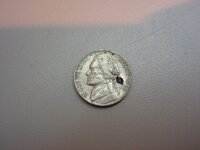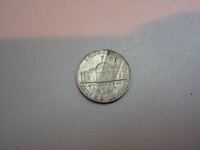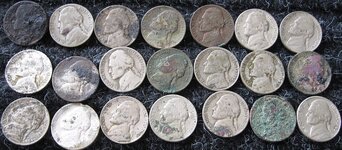Navigation
Install the app
How to install the app on iOS
Follow along with the video below to see how to install our site as a web app on your home screen.
Note: This feature may not be available in some browsers.
More options
You are using an out of date browser. It may not display this or other websites correctly.
You should upgrade or use an alternative browser.
You should upgrade or use an alternative browser.
Strange silver
- Thread starter mcmich
- Start date
mastereagle22
Silver Member
- May 15, 2007
- 4,909
- 31
- Detector(s) used
- E-trac, Explorer II, Xterra30, Whites Prizm IV
The 41-45s were 35% silver
Johnny Ringo Silver
Hero Member
I knew they were partially silver, but not sure on the process! Pretty odd though huh? 8)
mastereagle22
Silver Member
- May 15, 2007
- 4,909
- 31
- Detector(s) used
- E-trac, Explorer II, Xterra30, Whites Prizm IV
Well if you think about it what they do with a coin it take some metal and use it for the center of the coin and then put whatver metal they are going to finish it with on the outside, look at the quarter that's what they did here.
The core of the war nickels were different and the silver was a thin plating.
Silver "War" nickels were produced by the United States from mid-1942* through 1945. The coins were manufactured from 56% copper, 35% silver and 9% manganese. This allowed the saved nickel metal to be shifted to industrial production of miltary supplies during World War II.
Silver nickels are distinguised by a slightly different coloration than ordinary nickels and by the appearance of a large mintmark above Monticello's dome on the reverse side of the coin. The marks are "S" for the San Fransico mint, "D" for the Denver mint and "P' to indicate production at the Philadelphia mint, being the first coin to feature the Philadelphia intial, as no mint mark was the usual designation for Philadelphia mintage before 1979.
The core of the war nickels were different and the silver was a thin plating.
Silver "War" nickels were produced by the United States from mid-1942* through 1945. The coins were manufactured from 56% copper, 35% silver and 9% manganese. This allowed the saved nickel metal to be shifted to industrial production of miltary supplies during World War II.
Silver nickels are distinguised by a slightly different coloration than ordinary nickels and by the appearance of a large mintmark above Monticello's dome on the reverse side of the coin. The marks are "S" for the San Fransico mint, "D" for the Denver mint and "P' to indicate production at the Philadelphia mint, being the first coin to feature the Philadelphia intial, as no mint mark was the usual designation for Philadelphia mintage before 1979.
ClonedSIM
Silver Member
Hey ME,
I was checking because what I heard was that the wartime nickels were an amalgam of metals, rather than plated. But, when I was searching, I found a possible treasure lead, maybe?
An unofficial variety of the wartime coin dated 1944 was made in 1954 when counterfeit nickels were produced by Francis LeRoy Henning of Erial, New Jersey. He had previously been arrested for counterfeiting $5 bills. The 1944 nickels were quickly spotted since Henning neglected to add the large mintmark. [1] He also made counterfeit nickels dated 1939, 1946, 1947, and possibly 1953 as well as one other unidentified date [2]. It is estimated that more than 100,000 of Henning's nickels reached circulation. These can still be found in pocket change, and there is a thriving collectors' market for them, although owning a counterfeit is technically illegal. Henning dumped another 200,000 nickels in Copper Creek, New Jersey, of which only 14,000 were recovered. Another 200,000 are thought to have been dumped in the Schuylkill River. When caught, Henning was sentenced to 3 years in jail, and was required to pay a $5,000 fine.
I was checking because what I heard was that the wartime nickels were an amalgam of metals, rather than plated. But, when I was searching, I found a possible treasure lead, maybe?
An unofficial variety of the wartime coin dated 1944 was made in 1954 when counterfeit nickels were produced by Francis LeRoy Henning of Erial, New Jersey. He had previously been arrested for counterfeiting $5 bills. The 1944 nickels were quickly spotted since Henning neglected to add the large mintmark. [1] He also made counterfeit nickels dated 1939, 1946, 1947, and possibly 1953 as well as one other unidentified date [2]. It is estimated that more than 100,000 of Henning's nickels reached circulation. These can still be found in pocket change, and there is a thriving collectors' market for them, although owning a counterfeit is technically illegal. Henning dumped another 200,000 nickels in Copper Creek, New Jersey, of which only 14,000 were recovered. Another 200,000 are thought to have been dumped in the Schuylkill River. When caught, Henning was sentenced to 3 years in jail, and was required to pay a $5,000 fine.
BuckleBoy
Gold Member
My hunch is that this coin is Not a counterfeit one. The mintmark and details are correct on the coin. My guess is that since there were so many problems with the alloy used to create the wartime nickels, this one was struck on a defective planchet. My guess is that it is not silver plated, but perhaps had a defective spot in it, which discolored in the ground. The reverse has the normal streaking where the alloy didn't mix properly--a common problem with these coins.
Regards,
Buckles
Regards,
Buckles
daytondigger
Bronze Member
I've dug a few war nickels that have the same appearance, it's just the nature of the beast.
Captn SE
Silver Member
- Apr 1, 2007
- 2,774
- 13
- Detector(s) used
- Minelab Explorer SE; X-1 Target Probe; Pro Coil, 6x8 SEF, Coiltek Platypus Elliptical, Sunray X8, Expl. 1050 coils
It looks like an ordinary War Nickel to me. I found a handful of them last year. Here's a pic of them. You can see that many of them are corroded/chipped from the interaction of ground minerals and fertilizers in the turf. A good number of them have a black, tar-like substance on them. I assume it's the interaction of the manganese in the nickel with certain minerals/fertilizers in the ground. On some, you can see the chipped silver surface, and a copper alloy underneath.
HH,
CAPTN SE
Dan
HH,
CAPTN SE
Dan
Attachments
allen
Gold Member
- Jul 16, 2004
- 20,059
- 212
- Detector(s) used
- ace 250
- Primary Interest:
- Metal Detecting
that nickel is really neat looking...
Top Member Reactions
-
 3663
3663 -
 1992
1992 -
 1881
1881 -
 1488
1488 -
 1248
1248 -
 1092
1092 -
 1078
1078 -
 985
985 -
 856
856 -
 727
727 -
 659
659 -
 574
574 -
 476
476 -
 472
472 -
 440
440 -
E
429
-
 399
399 -
 397
397 -
 390
390 -
 381
381
Users who are viewing this thread
Total: 2 (members: 0, guests: 2)








